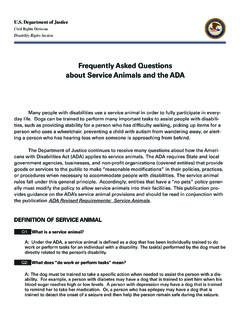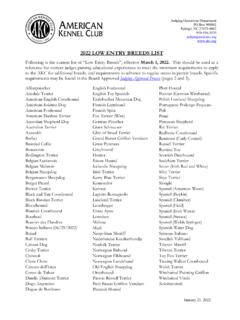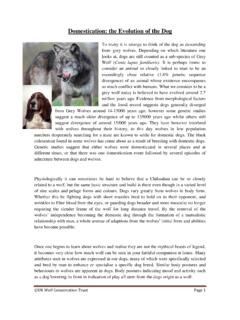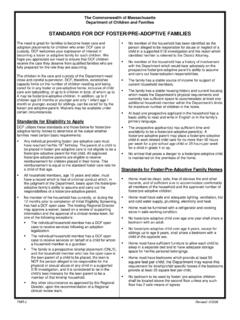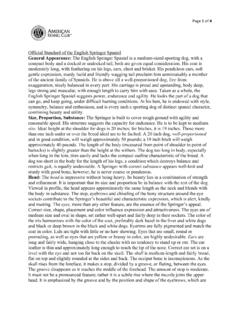Transcription of manual and training guide - ASPCApro
1 manual and training guide2forwardIn 2007, the American Society for the Prevention of Cruelty to Animals (ASPCA ) acquired safer (Safety assessment for Evaluating Rehoming).The ASPCA invites you to learn about the program which will help you to better know the dogs in your care, by identifying which dogs in your shelter or rescue group are ready to go into yourplacement program, which ones will benefit from behavior modification and which ones will needcareful management if they are to be placed. The heart of the safer program is an aggressionassessment tool designed by Emily Weiss, , CAAB, for the Kansas Humane Society in 1999, Kansas Humane Society approached Dr. Weiss to develop an aggression assessment that could identify safe, adoptable dogs which would be short, accurate and cost little to implement concerns shared by most shelter organizations. Initially, safer was a six-item assessmentwhich could be completed in less than six minutes utilizing an Assessor and an Observer, shelterstaff who were knowledgeable about dog behavior and possessed excellent observation and safeanimal handling skills.
2 Since its inception, a seventh item has been added toy behavior so theassessment now takes a couple of minutes longer per the addition of a seventh assessment item, the safer program has grown in other her work with Southern and Midwestern shelters taking part in the Rescue Waggin AnimalTransport Program sponsored by PetSmart Charities and the ASPCA, Dr. Weiss came to realizethe importance of Assessor Certification, to ensure that safer Assessors were all consistent intheir execution of the program. (See safer Certification chapter for more information.)Throughher shelter intern program, behavior modification protocols for common behavior issues such as foodbowl aggression and touch-sensitivity have been tested and modified and are now available so thatafter those problems are identified in the assessment , shelter behavior staffers can take safer is the first tool developed by Dr.
3 Emily Weiss, MYM Canine-alitywas subsequentlydesigned by going beyond an aggression assessment to help best match individual dogs withadopters lifestyles and expectations. Dr. Emily Weiss also researched and developed other match-making programs for puppies and cats, Puppy-ality and Feline-ality , respectively. To learn more about the ASPCA s safer and Meet Your Match programs, visit should assessusing the safer assessment an overviewfacility requirements and equipmentthe safer assessment item by itemutilizing the safer worksheetrole of the observerSAFER certificationbehavior modification and management protocolsglossaryreproducible forms and templates47111315193741434765694 ASPCA safer is a seven item aggressionassessment that identifies the dog s comfort levelwith restraint and touch, reaction to new experiencesincluding movement and sound stimuli, bite inhibition,behavior around food and toys, and arousal leveltoward other dogs.
4 The dog s behavioral response tothese assessment items and the organization sStandard Operating Procedures (SOP) determine thenext steps to be taken with the utilize an aggression assessmentShelters that employ safer or other research-based behavior assessments report feweraggression complaints, more adoptions, and betterclient interactions. Simply put, they are able to moreaccurately communicate to the adopter about whatthey should expect, and how to best manage, a dogin their home. safer demands staff time, facility space and a passel of supplies; and at times, it can raisecontroversy. Why should shelters assess their dogs?Short answer: it s the prudent thing to do. A prudentshelter is one that employs good judgment andcommon sense. It is prudent to have a validatedscientific tool to back up that gut feeling that thedog identified as good with kids and first-time petguardians has the highest probability to be a safechoice for them.
5 It is prudent to determine which dogs will flourish when given some behaviormodification for the quirks and foibles identified by the assessment . It is prudent to put in place aconsistent assessment procedure when determiningwhich dogs are most likely to be a danger to staff,volunteers, potential adopters and the community atlarge, so that next-step discussions will center aroundwhat to do with the dog, not around what was done to the dog. These are the reasons to find the stafftime and spend the money necessary to employ anaggression assessment . In an age where lawsuitsare common and insurers are scarce, not to do sowould the scoring meansWhen a dog scores 1s and 2s on his assessment ,he is less likely to bite under ordinary living situationswhen handled in a mildly stressful or moderatelyawkward manner than dogs who score 3s, 4s and 5s. Dogs that score 3s may be safe and inhibittheir bite, but they could be made safer by puttingthem on a behavior modification program.
6 Dogs thatscore 4s may have serious fear or intolerance issuesand should either receive behavior modificationtraining and then be reassessed or only be adoptedout to experienced adopters ready to manage thedog s issues. Dogs whose behavior during one of thefirst four assessment items score a 5 have theShelters that employ safer or other research-based behaviorassessments report feweraggression complaints,more adoptions, and betterclient safer guide5highest probability to be a serious danger to staff,volunteers and visitors to the facility. (See Researchpages 7 10 for more information.) They should onlybe handled by the shelter s most experienced staffuntil their disposition is determined. These dogs mayrespond well to behavior modification or they may next stepsOnce a dog is assessed and his behavior responsesnoted, the assessment team should review hisworksheet. If any of the canine behaviors displayedwere reason for concern, the team should first reviewthe assessment video to ensure there was nothingimproper in the way the assessment was conductedor the way the dog was handled that attributed to the dog s particular response.
7 If all was done by thebook, the dog s assessment should be brought to the attention of the Animal Behavior or Animal CareSupervisor to determine next steps. As each shelteris unique and has different resources available, nextsteps will vary from staff and cage space is available, the dog might be given another twenty-four hours to settle into his surroundings and then be re-assessed. If theshelter employs a behavior staff, the dog may be put on a behavior modification program and re-assessed after the program is complete. Someshelters have behavior foster homes in which tohouse dogs with potential behavior issues for a trialperiod. Experienced foster volunteers would followthrough with the shelter s behavior modificationprogram and observe the dog s behavior in a reallife setting. Shelterswithout behavior departmentsmay utilize community dog trainers to either deviseadditional behavior modification protocols, work with the shelter dogs or serve as behavior fosterhomes paid or unpaid.
8 A local rescue group may be interested in taking the dog. Sharing theassessment with the group allows them to make aninformed decision about whether or not they have theresources to meet the animal s your facility may be an overcrowded, high volume, open access animal care and control with few resources and no Friends of the Sheltergroup. Your shelter may not even be able to assessevery dog over six months of age. In this case, safer might only be used to help identify thebehaviorally soundest pit bulls and guarding breedsto insure that those placed up for adoption will be great ambassadors for both their breeds and your shelter. The safer assessment may help supervisors make euthanasia decisions, but the assessmentalone should never be the only input surveys done at intake, veterinaryreports from the health check, and input from animalcare technicians, volunteers, and foster parentsshould also be considered whenever a life or death decision must be focus of Dr.
9 Emily Weiss graduate career was on the selection of service dogs from research, which was conducted at the KansasHumane Society of Wichita (KHS), focusedspecifically on developing a set of assessment items that would better predict service dog potentialin dogs selected from shelters. This work waspublished in The Journal of Applied AnimalBehaviour and the Journal of Applied AnimalWelfare Science (1997, 2002). During the datacollection period, the KHS expressed an interestin having a research-based assessment to helpidentify potential aggression. They had a highnumber of reports of aggression about their adopteddogs. Several of the assessment items researchedfor the service dog work focused on arousal, fear,and other potential issues, making a good base for a potential aggression assessment . safer was developed based on the needs and resources of the Kansas Humane Society of Wichita (KHS).
10 The open admission facility was, like most facilities, short staffed. The time allotted for anassessment was about six minutes per dog. Itemsfrom the earlier research were added to a foodaggression assessment that was already availablefor shelter use (Assess-a-Pet , Sue Sternberg). Staffwas trained on the assessment process and then thesix item assessment was tested on a sample of sample was derived from dogs entering dogs were randomly assigned a number as theyentered the facility. If the number was odd, the dogwas placed in Group 1, if the number was even, thedog was placed in Group 2. All dogs that enteredwithout a bite report and were considered by thefacility to be healthy were included in the 1:These dogs were assessed using safer and received 1s and 2s on the assessment . group 2:These dogs were not assessed. They weregiven a thorough health exam; and if theyaggressed during the exam, they were notincluded in the study.

